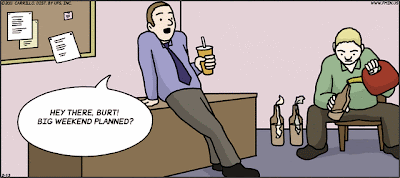
He sent me a running question the other day:
"I'm starting to experience some pain on the outside of my right knee after I run. For example, I did eight miles this morning and was fine while running. When I got home, the pain really started kicking in just walking around the house. The pain seems to occur at the point when I step forward with my right foot. Any ideas? It has been happening for a few weeks now and seems to come and go. I did six miles on Monday evening and didn't have any trouble. Thanks for any help. I definitely don't want to mess up my knee."
When I sent my response back to Brett, I initially suspected iliotibial band syndrome because of the location and intermittent nature of the pain. The only other overuse injury I can think of would be patellofemoral syndrome, or "runner's knee", which would have the pain at the lower margin of the knee; the IT band would be at the upper or outer margin of the knee.
Either way, Brett has an overuse injury.
He later revealed to me he went from running five to running ten miles at a time over a four-week span, which came from training with a triathlon training group at their local YMCA. "Guess I was trying a little too hard and too quick to hang with the 'A Group'", was his lament.
When an overuse injury such as IT band syndrome, achilles tendinosis, plantar fasciitis, patellofemoral syndrome comes to pass, most of the root causes are these:
1. Old, worn-out, or improper running shoes. If the runner cannot say how long (in time or miles) they have run in a particular pair of shoes they might have run in them too long. Sometimes an old pair of shoes will give fair warning by "smelling dead," or the runner might suffer from some aches and pains in the ankles, feet, knees or lower back. Naturally, the remedy would be to get into a pair of shoes which best fits the foot type. Most experienced runners know what kind of shoes work best for them. Once in a while a particular model of shoe changes construction or materials, so it doesn't hurt (no pun intended) to have a "short list" of acceptable shoe models. The major running magazines do annual shoe reviews which can make the search more simple, or a running speciality store can point the individual runner to the "short list."
2. Significant changes in training volume, terrain, or surface. A short-term (or even a long-term) business trip or a new training group can wreak havoc on a training cycle. Most good training schedules aren't necessarily (and probably shouldn't be) written in stone. I've discussed with my coach/advisor about synchronizing my workouts with my coaching; some times solitary training sessions are necessary to train at the proper (read: easier) intensity. Look closely at the recent changes, then subtract them for about three weeks. Why three weeks? That's how long it takes for the body to benefit completely from a change in training volume or intensity, or the minimum time it takes for a low-level overuse injury to begin healing.
And when adding distance/duration to a workout, the "ten percent every three weeks" rule of thumb is best. When talking ten percent, the addition of time/distance should be spread across the training week as much as possible. For example:
OLD WEEK - 30 miles/week
- Sunday - 6 miles
- Monday - Rest
- Tuesday - 6 miles
- Wednesday - 6 miles
- Thursday - 6 miles
- Friday - Rest
- Saturday - 6 miles
NEW WEEK - 33 miles/week
- Sunday - 7 miles
- Monday - Rest
- Tuesday - 6.5 miles
- Wednesday - 6.5 miles
- Thursday - 6.5 miles
- Friday - Rest
- Saturday - 6.5 miles
I've met runners who tacked the ten percent on the Sunday run, which in the example above would increase the volume of that day by 50 percent and increase the longest run of the week to more than 20 percent of the week's volume. Neither one of those are a good idea. If there's a time crunch during the week the additional miles could be split between Saturday and Sunday, but even then there would be the risk of adding too much stress too soon.
And, regardless, cambered roads and hill running can wreak havoc on the unprepared runner. Stress injuries abound from too much "new" (surface, distance, or intensity), too soon.
3. Muscle weakness, especially in the calves, gluteus medius, and abdomen. When a runner has weak muscles or muscle imbalance it puts undue strain on the rest of the "drivetrain." I sent Brett a link to a YouTube video (http://www.youtube.com/watch?v=5RC7VH3bEB4) with some exercises to strengthen his glutes and stretch the IT band. Six of ten runners who make these changes can recover from a low-level overuse injury in as little as three weeks, with the remainder recovering in six weeks. There are those cases (this coach included) where recovery can take up to six months; more of a compliance and patience issue than anything else.
Brett sent a reply which ended with:
"I signed up for a ten-miler this coming Sunday. I want to finish it, then my plan is to go back to six miles and see how I do. If I still am having problems, I'll keep backing off until I stop having problems and may look into seeing a physical therapist. Once I figure out where my baseline is, I'll start slowly increasing my distance again, only this time at a reasonable pace."
When it comes to training, and especially when it comes to recovering from an overuse injury: Your ego is not your amigo.


1 comment:
Michael ... I would suspect patella tendonitis ... simple stengthening exercises should take care of the problem ... Coach
Post a Comment